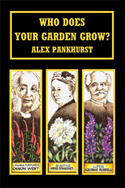B. B. Mackey Books
Who Does Your Garden Grow?, Excerpt
Contact Us
Books and Products for Sale About the Authors
Monica Brandies
Free How-to Directions: Make Troughs Three Ways
Events
Book Links
book: Best of Green Space book: Citrus: How to Grow and Use Citrus Fruits, Flowers, and Foliage book: Creating and Planting Alpine Gardens
books: Garden Notebooks
book: Q and A for Deep South Gardeners, 2nd Ed. Books: Rock Gardening Garden Book by Mackey
Customer Testimonials
Horticultural Notecards
Garden T-Shirts Art Gallery
Parade of Troughs Horticultural Notecards
Gardening Tips Spring Garden Tips
Fall Notes
Summer Tips
Herbs in Fall
Tips for New Gardens
Tips: Edible Flowers
Winter Reading
Book Reviews
Container Gardening Tips For Bookstores and Libraries
Canadian Orders
Garden Links
 006. All rights reserved. Do not copy without permission from the publisher.
006. All rights reserved. Do not copy without permission from the publisher.Buy the book now $14.50 USD, postage to USA and Canadian addresses included.
E. C. BUXTON, 1838—1925
Anthemis tinctoria 'E. C. Buxton'
Geranium wallichianum 'Buxton's Variety'
Edmund Charles Buxton was born in Hendon, the son of a prosperous Quaker family, and great nephew of Sir Thomas Fowell Buxton, the campaigner against slavery. Little is known about Edmund's life, and why or when he moved to North Wales, but by the time his name became known in gardening circles he was living at Betwys-y-Coed.
Coed Derw, his spacious home there, was set amidst magnificent scenery.A wooded mountainside rose steeply behind the house, and the large garden sloped in a series of winding paths down to the Conway, the roar of the river filling the air after heavy rain.
Buxton, a knowledgeable plantsman, contributed to gardening magazineson many topics, and had a varied and extensive circle of gardening friends, including A. T. Johnson (qv), who lived further down the valley. Despite high rainfall, a broad range of things thrived in the garden at Betws-y-Coed, which contained a wonderful collection of plants.
Several plants are known to have originated in E. C. Buxton's garden, including the white form of Lamium orvala, and a Sedum spathulifolium with blood crimson leaves. At least three bore his name but have not survived.
Luckily Anthemis tinctoria 'E. C. Buxton' has a strong will to live.Anthemis tinctoria is a particularly useful border plant, being hardy,and tolerant of most conditions, with yellow daisy flowers all summer.The usual colour is a strong yellow, but before the First World WarBuxton had one with lemon-coloured flowers. Whether it originatedas a seedling or a chance mutation is not known, but it was much admired by his many visitors, who were duly given offshoots. When a piece of this pale form reached E. A. Bowles (qv), he called it 'one of the delights of my garden', and the plant has retained its popularity ever since.
Primroses were easily grown at Coed Derw, enjoying the high rainfall,and in 1901 E. C. Buxton was pricking out a box ofblue-flowered single primrose seedlings. Not bothering with the poorest,he was going to discard them, but his softer-hearted wife took them away to plant in the kitchen garden. Next year, going round together, they found one of these rescued plants bore double, almost turquoise blue flowers—the best double, blue primrose ever produced, according to a friend. After E. C. Buxton's death his widow sent the primrose to a great nephew, who exhibited it at the Royal Horticultural Society.Primula vulgaris 'Buxton's Blue' was not blessed with a strong constitution,however, and seems no longer to be with us.
Geranium wallichianum from the North Eastern Himalayas is much more robust. Introduced to this country early in the nineteenth century, its natural flower colour is a mauvey blue surrounding a white centre, but Buxton grew a much better form. This bore blooms which A. T. Johnson observed, were 'so nearly blue that it needs none of the catalogue makers licence to call them so'. It was given away generously to other gardeners, becoming known as Geranium wallichianum 'Buxton's Variety'. Nowadays his form has almost supplanted the original Himalayan native,and adds a valuable touch of clear blue to later summer.
In 1925, still working in his beautiful garden, E. C. Buxton was overcomeby the heat of a July day and died, aged eighty-seven, mourned by numerous gardening friends. 'He was', said A. T. Johnson, 'above all else a grand old English gentleman'.